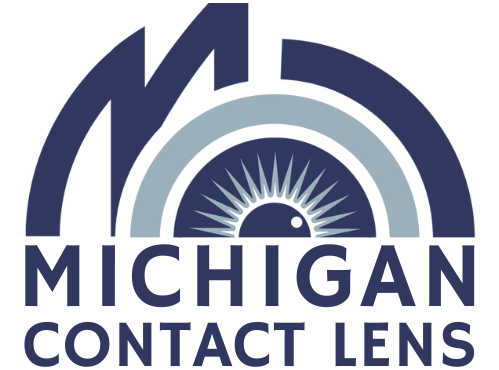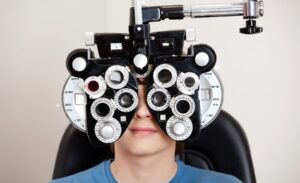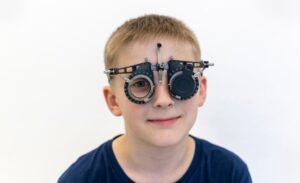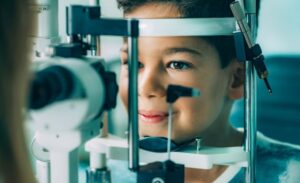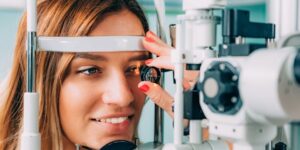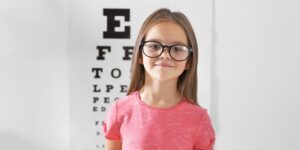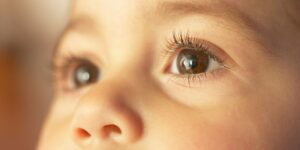Myopia, commonly known as nearsightedness, is a refractive error that affects the ability to see distant objects clearly. This condition has become increasingly prevalent, especially among children. Fortunately, advancements in eye care have led to the development of effective myopia control strategies to address this issue.
What is Myopia?
Myopia is a vision condition characterized by the inability to see distant objects clearly while maintaining good near vision. People with myopia experience blurred vision when looking at objects in the distance, such as signs, chalkboards, or television screens. This occurs because the eyeball is slightly elongated or the cornea is too curved, causing light to focus in front of the retina instead of directly on it.
The exact cause of myopia is not fully understood, but it is believed to be influenced by a combination of genetic and environmental factors. Spending excessive time engaged in near work activities, such as reading or using electronic devices, has also been associated with the development and progression of myopia.
The Importance of Myopia Control
Addressing myopia early on is crucial for several reasons. Firstly, myopia tends to progress during childhood and adolescence, often stabilizing in early adulthood. Slowing down the progression of myopia can help prevent high myopia, which is associated with an increased risk of eye diseases such as cataracts, glaucoma, and retinal detachment later in life.
Secondly, myopia can significantly impact a child’s quality of life and academic performance. Struggling to see clearly can affect their ability to learn, participate in sports, and engage in various activities. Therefore, taking proactive steps to control myopia can have a positive impact on a child’s overall well-being.
Introducing Myopia Control Contact Lenses
One effective method for myopia control is the use of myopia control contact lenses. These specialized contact lenses are designed to slow down the progression of myopia in children and adolescents. There are different types of myopia control contact lenses available, each offering unique features and benefits.
Dual Focus Lenses are one type of myopia control contact lens that utilizes a center-distance design. These lenses allow clear vision for both near and distance objects, simultaneously reducing the strain on the eyes and helping to slow down myopia progression.
Orthokeratology (Ortho-K) Lenses, also known as overnight lenses, are another option. These lenses are worn during sleep and gently reshape the cornea, temporarily correcting myopia. By wearing Ortho-K lenses overnight, individuals can enjoy clear vision throughout the day without the need for glasses or contact lenses. However, it’s important to note that the effects of Ortho-K lenses are reversible, and continuous wear is required to maintain the results.
Multifocal Contact Lenses are designed with multiple lens powers to provide clear vision at various distances. These lenses help to reduce the strain on the eyes and slow down the progression of myopia.
Consulting with an eye care professional is essential to determine the most suitable type of myopia control contact lenses for a child. They will consider factors such as the child’s age, eye health, lifestyle, and visual needs to recommend the best course of action. Regular check-ups and monitoring are also crucial to ensure the lenses are providing the intended benefits.
Myopia control contact lenses offer a proactive approach to managing myopia in children. By slowing down the progression of myopia, these lenses can contribute to better long-term vision health and an improved quality of life. Visit our article on myopia control lenses for a more comprehensive understanding of the available options.
How Myopia Control Contact Lenses Work
Myopia control contact lenses are an effective solution for managing the progression of myopia in children. These specialized lenses utilize various mechanisms to help slow down the rate of myopia progression. Let’s explore three common types of myopia control contact lenses: dual focus lenses, orthokeratology (ortho-K) lenses, and multifocal contact lenses.
Dual Focus Lenses
Dual focus lenses, also known as multifocal lenses, are designed with different zones that correct both near and distance vision. The lens has a central zone for distance vision and a peripheral zone for near vision. By providing clear vision at different distances, these lenses help to reduce eye strain and the stimulus for myopia progression. The peripheral defocus created by the lens helps to slow down the elongation of the eye, which is a key factor in myopia progression.
Orthokeratology (Ortho-K) Lenses
Orthokeratology, commonly referred to as ortho-K, is a myopia control method that involves wearing specially designed gas-permeable contact lenses overnight. These lenses gently reshape the cornea, temporarily correcting the refractive error and providing clear vision during the day without the need for glasses or contact lenses. Ortho-K lenses work by applying specific pressures to the cornea, redistributing the corneal cells and altering the curvature. This temporary reshaping effect helps to slow down the progression of myopia.
Ortho-K lenses are particularly beneficial for children who may not be comfortable wearing contact lenses during the day. They offer the convenience of clear vision without the need for corrective lenses, making them a popular choice among parents and children alike.
Multifocal Contact Lenses
Multifocal contact lenses for myopia control are similar to multifocal lenses used for presbyopia. These lenses have different zones that correct vision at various distances. By providing simultaneous vision correction for both near and distance vision, multifocal contact lenses help to slow down the progression of myopia. The specific design of these lenses allows the eyes to focus on objects at different distances, reducing the stimulus for myopia progression.
It’s important to note that the selection of the most suitable myopia control contact lens type should be determined by an eye care professional after a thorough examination and consultation. They will consider factors such as the child’s age, prescription, and lifestyle to determine the optimal lens type for myopia control.
By utilizing advanced optical designs, myopia control contact lenses offer a proactive approach in managing myopia in children. These lenses can help slow down the progression of myopia and potentially reduce the risk of associated eye conditions. To ensure the best outcome, it is essential to follow the recommended lens care and maintenance guidelines, as well as schedule regular eye exams to monitor the effectiveness of the lenses.
Benefits of Myopia Control Contact Lenses
Myopia control contact lenses offer several advantages in the management and treatment of myopia. By slowing down the progression of myopia and reducing the risk of associated eye diseases, these specialized lenses provide an improved quality of life for individuals with myopia.
Slowing Down Myopia Progression
One of the key benefits of myopia control contact lenses is their ability to slow down the progression of myopia. Compared to traditional glasses or regular contact lenses, myopia control lenses utilize advanced designs and optical principles to help limit the elongation of the eyeball that leads to increasing myopia.
Studies have shown that myopia control contact lenses, such as dual focus lenses, orthokeratology (ortho-K) lenses, and multifocal contact lenses, can effectively slow down the progression of myopia by an average of 50%. By wearing these lenses as prescribed by an eye care professional, individuals with myopia can have a better chance of maintaining clearer vision over time.
Reducing the Risk of Eye Diseases
Myopia is associated with an increased risk of developing various eye diseases, such as macular degeneration, glaucoma, and retinal detachment. By utilizing myopia control contact lenses, individuals can significantly reduce the risk of these sight-threatening conditions later in life.
By slowing down the progression of myopia, myopia control contact lenses help to minimize the stretching and thinning of the retina, which are factors that contribute to the development of these eye diseases. This reduction in risk is especially important for individuals with high myopia, as they are more susceptible to vision-threatening complications.
Improved Quality of Life
Wearing myopia control contact lenses can greatly improve the quality of life for individuals with myopia. By effectively managing the progression of myopia, these lenses help individuals maintain clearer vision, reducing their reliance on glasses or contact lenses for everyday tasks.
Furthermore, myopia control contact lenses can positively impact a child’s academic and social life. By slowing down the progression of myopia, these lenses can potentially reduce the need for frequent prescription changes, minimizing the disruption to a child’s education. Additionally, clearer vision can boost a child’s self-confidence and enhance their overall well-being.
By choosing myopia control contact lenses, individuals with myopia can experience the benefits of reduced progression, lower risk of eye diseases, and an improved quality of life. It is important to consult with an eye care professional to determine the most suitable type of myopia control contact lens for your specific needs. Regular eye exams and proper lens care and maintenance are also essential for maximizing the benefits of these lenses. For more information on myopia control and other treatment options, visit our articles on myopia control and myopia control lenses.
Considerations for Myopia Control Contact Lenses
When considering myopia control contact lenses for your child, there are several important factors to keep in mind. These considerations ensure that your child receives the best possible care and achieves optimal results in managing their myopia.
Consultation with an Eye Care Professional
Before starting myopia control contact lenses, it is essential to schedule a consultation with an experienced eye care professional. They will conduct a comprehensive eye examination and evaluate your child’s suitability for contact lens wear. During this consultation, the eye care professional will discuss the different myopia control options available, explain the benefits and potential risks, and address any concerns or questions you may have. This personalized guidance is crucial in determining the most suitable myopia control strategy for your child’s unique needs.
Proper Lens Care and Maintenance
Proper care and maintenance of myopia control contact lenses are crucial for ensuring their effectiveness and safety. It is essential to follow the prescribed cleaning and disinfection routine recommended by the eye care professional. This includes using appropriate cleaning solutions and following proper hygiene practices, such as washing hands before handling the lenses. By adhering to the recommended care instructions, you can minimize the risk of eye infections and maintain the lenses’ performance.
Monitoring and Regular Eye Exams
Regular monitoring and follow-up appointments with the eye care professional are essential when using myopia control contact lenses. These appointments allow the eye care professional to assess the effectiveness of the lenses, monitor any changes in your child’s myopia progression, and make any necessary adjustments to the treatment plan. Routine eye exams also help identify any potential issues early on, ensuring the continued health and well-being of your child’s eyes.
To learn more about myopia control and other treatment options, you can visit our articles on myopia control, myopia control lenses, and myopia control research. Remember, every child’s myopia control journey is unique, and consulting with an eye care professional is vital in determining the most appropriate approach for your child’s needs.
Empowering Children with Myopia Control Contact Lenses
For children who require vision correction due to myopia, myopia control contact lenses can be a game-changer. These specialized lenses not only help manage myopia progression but also empower children in various aspects of their lives. Let’s explore how myopia control contact lenses can boost self-confidence, promote an active lifestyle and sports participation, and contribute to long-term vision health.
Boosting Self-Confidence
Wearing eyeglasses can sometimes make children self-conscious about their appearance. Myopia control contact lenses provide an alternative solution that allows children to enjoy clear vision without the need for visible eyewear. By being able to see clearly without glasses, children may experience a boost in self-confidence and feel more comfortable in social situations. This newfound confidence can positively impact their interactions with peers and contribute to their overall well-being.
Active Lifestyle and Sports Participation
One of the challenges for children with myopia is participating in sports and other physical activities while wearing glasses. Myopia control contact lenses eliminate this obstacle, allowing children to engage in sports without worrying about the limitations of eyeglasses. These lenses provide clear vision, unhindered peripheral vision, and a stable fit during physical activities. With myopia control contact lenses, children can fully enjoy their favorite sports and lead an active lifestyle, contributing to their physical development and overall health.
Long-Term Vision Health
Beyond the immediate benefits, myopia control contact lenses also play a crucial role in the long-term vision health of children. By slowing down the progression of myopia, these lenses can help reduce the risk of developing associated eye conditions later in life, such as retinal detachment, glaucoma, and macular degeneration. By addressing myopia early on with appropriate treatments like myopia control contact lenses, parents can help safeguard their children’s vision for the future.
It’s important to note that the decision to use myopia control contact lenses for children should be made in consultation with an eye care professional. A comprehensive eye exam and assessment will determine if these lenses are suitable for your child’s specific needs. Regular monitoring and follow-up exams are also essential to ensure the lenses continue to provide effective myopia control. For more information on myopia control, check out our article on myopia control.
Myopia control contact lenses offer a range of benefits for children, from boosting self-confidence to supporting an active lifestyle and promoting long-term vision health. By considering these lenses as a viable option, parents can empower their children to live their lives to the fullest while effectively managing myopia.
